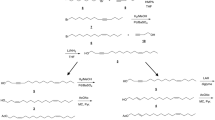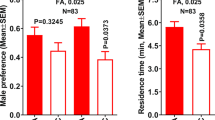Abstract
Source concentration differences of (Z)-7-dodecen-1-ol acetate, or looplure, were evaluated for field trapping efficiency and electrophysiological responses with malePseudoplusia includens (Walker),Trichoplusia ni (Hubner) andRachiplusia ou (Guenné) (Lepidoptera: Noctuidae). Sticky traps baited with 1000 μg of the lure captured a significantly greater (P < 0.05) number of maleP. includens andT. ni than any other concentration;R. ou males were caught at a greater rate in traps baited with 100 μg of looplure, significantly more (P < 0.05) than with 1000 μg. Electroantennogram (EAG) studies demonstrated that antennae of maleP. includens have a lower response threshold to looplure than eitherT. ni orR. ou antennae, the latter demonstrating the highest significant threshold of response. No differences in the stimulus-response functions of the three species were detected.
Similar content being viewed by others
References
Barr, A. J., Goodnight, J.H., Sail, J.P., andHelwig, J.T. 1976. A User's Guide to SAS 76. SAS Institute Inc., Raleigh, North Carolina, 329 pp.
Berger, R.S. 1966. Isolation, identification, and synthesis of the sex attractant of the cabbage looper,Trichoplusia ni.Ann. Entomol. Soc. Am. 59:767–771.
Berger, R.S., andCanerday, T.D. 1968. Specificity of the cabbage looper sex attractant.J. Econ. Entomol 61:452–454.
Bjostad, L.B., Gaston, L.K., Noble, L.L., Moyer, J.H., andShorey, H.H. 1979. Dodecyl acetate, a second pheromone component of the cabbage looper moth.Trichoplusia ni. J. Chem. Ecol. 6:727–734.
Burton, R.L. 1969. Mass Rearing the Corn Earworm in the Laboratory. USDA, ARS 33–134.
Butler, L.I., Halfhill, J.E., McDonough, L.M., andButt, B.A., 1977. Sex attractant of the alfalfa looperAutographa californica and the celery looperAnagrapha falcifera (Lepidoptera: Noctuidae).J. Chem. Ecol. 3:65–70.
Cardé, R.T. 1979. Behavioral responses of moths to female-produced pheromones and the utilization of attractant baited traps for population monitoring, pp. 286–315, in R.L. Rabb and G.G. Kennedy (eds.). Movement of Highly Mobile Insects: Concepts and Methodologies in Research. University Graphics, North Carolina State University, Raleigh, North Carolina, 456 pp.
Eichlin, T.D. 1975. Guide to the adult and larval Plusiinae of California. Occasional Papers in Entomology, State of California. Department of Food and Agriculture No. 21, 73 pp.
Kaae, R.S., Shorey, H.H., andGaston, L.K. 1973. Pheromone concentration as a mechanism for reproductive isolation between Lepidopterous species.Science 179:487–448.
Light, D.M., andBirch, M.C. 1979. Electrophysiological basis for the behavioral response of male and femaleTrichoplusia ni to synthetic female pheromone.J, Insect Physiol. 25:161–167.
Lingren, P.D., Sparks, A.N., Raulston, J.R., andWolf, W.W. 1978. Applications for nocturnal studies of insects.Bull. Entomol. Soc. Am. 24:206–212.
Mayer, M.S. 1973. Electrophysiological correlates of attraction inTrichoplusia ni.J. Insect Physiol. 19:1191–1198.
McLaughun, J.R., Mitchell, E.R., Beroza, M., andBierl, B.A. 1975. Effect ofE-Z concentration of 7-dodecenyl acetate on captures of four noctuid species in pheromone traps.J. Ga. Entomol. Soc. 10:338–341.
Minks, A.K., 1977. Trapping with behavior-modifying chemicals: Feasibility and limitations, pp. 385–394,in H.H. Shorey and J.J. McKelvey, Jr. (eds.) Chemical Control of Insect Behavior: Theory and Application. John Wiley & Sons, New York, 414 pp.
Payne, T.L., Shorey, H.H., andGaston, L.K. 1970. Sex pheromones of noctuid moths: Factors influencing antennal responsiveness in males ofTrichoplusia ni.J. Insect Physiol. 16:1043–1055.
Roelofs, W.L. 1978a. Threshold hypothesis for pheromone perception.J. Chem. Ecol. 4:685–699.
Roelofs, W.L. 1978b. Chemical control of insects by pheromones, pp. 419–464,in Morris Rockstein (ed.). Biochemistry of Insects. Academic Press, New York, 649 pp.
Roelofs, W.L., andComeau, A. 1971. Sex pheromone perception: Electroantennogram responses of the red-banded leaf roller moth.J. Insect. Physiol. 17:1969–1982.
Roelofs, W., Comeau, A., Hill, A., andMilicevic, G. 1971. Sex attractant of the codling moth: Characterization with electroantennogram technique.Science 174:297–299.
Schneider, D. 1957. Elektrophysiologische Untersuchungen von Chemo und Mechanorezeptoren der Antenne des SeidenspinnersBombyx mori. L.Z. Vergl. Physiol. 40:8–41.
Shorey, H.H. 1976. Animal Communication by Pheromones. Academic Press, New York, 167 pp.
Shorey, H.H., Gaston, L.K., andRoberts, J.S. 1965. Sex pheromones of noctuid moths. VI. Absence of behavioral specificity for the female sex pheromone ofTrichoplusia ni versusAutographa californica, andHeliothis zea versusH. virescens (Lepidoptera: Noctuidae).Ann. Entomol. Soc. Am. 58:600–603.
Steck, W., Underhill, E.W., Chisholm, M.D., andGerber, H.S. 1979. Sex attractant for male alfalfa looper moths,Autographa californica (Speyer).Environ. Entomol. 8:373–375.
Tamaki, Y. 1977. Complexity, diversity, and specificity of behavior-modifying chemicals in Lepidoptera and Diptera, p. 253,in H.H. Shorey and J.J. McKelvey, Jr. (eds.). Chemical Control of Insect Behavior: Theory and Application. John Wiley & Sons, New York, 414 pp.
Tumlinson, J.H., Mitchell, E.R., Browner, S.N., andLindquist, D.A. 1972. A sex pheromone for the soybean looper.Environ. Entomol. 1:466–468.
Author information
Authors and Affiliations
Additional information
Lepidoptera: Noctuidae.
Rights and permissions
About this article
Cite this article
Alford, A.R., Hammond, A.M. Looplure efficacy and electrophysiological responses in three plusiinae species. J Chem Ecol 8, 1455–1462 (1982). https://doi.org/10.1007/BF00989102
Received:
Revised:
Issue Date:
DOI: https://doi.org/10.1007/BF00989102




